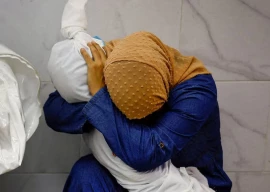
MINGORA:
If a lone study is to be believed, the stream which cuts through Mingora, Swat is fed 75 tonnes of waste on a daily basis. While locals cannot corroborate, they firmly believe this is no longer a ‘fresh’ water source.
Toti Khan, who runs a hotel atop the stream, recalls standing on the two steps he built at the edge of the bank and taking a drink of water during his youth. “In the early eighties, I didn’t think twice before drinking this water. Now I cannot even imagine walking through it without a hundred thoughts crossing my mind about the condition of the water. This pollution has magnified in the last fifteen years” he adds.
Like Toti Khan, many others lament the polluted water in the stream flowing through Mingora city. “Can you imagine, we used to drink water from this stream; women would bathe in it too,” Isa Khan, a resident of Landi Kas, tells The Express Tribune.
Akhtar Ali, an official of Environmental Protection Society, says, “Since the late eighties, pollution of freshwater sources in Mingora city increased, coinciding with the rise in the number of patients being diagnosed with water-borne diseases.” He explains the shape of the streams had also changed.
Pollution became even more persistent since the military operation in Swat in the late 2000s. “The stream was filled with corpses of dogs, militants, civilians and security forces,” he adds.
Ali believes reconstruction in the valley adds to the problem as sewage systems have been lead into the stream.
Sumaira Bibi who conducted research (circa 2012) on waste dumped into the streams in Mingora concurred with Akhtar Ali. “Water samples from various parts of the district revealed it was fit for drinking till 1998, when the city was less populated.”

She tells The Express Tribune, “But since most of sewage lines flow into the streams now, contamination is hard to avoid. The government had started to rehabilitate mid-stream but abandoned the project after it found out more than 75 tonnes of waste—both solid and liquid—is disposed in the stream directly and indirectly, making it nearly impossible to be cleaned.”
Sumaira Bibi says the sources of the stream, Jambel and Marghuzar valleys, have hardly any water left now. “Due to excessive deforestation in these valleys, the quantity of water has reduced extensively. Furthermore, the area does not receive any snowfall.” She adds water, a basic necessity, becomes a dangerous product for consumption once it is polluted.
Dengue hub
Dr Shah Zaman, a physician in Saidu Teaching Hospital, says the water from this stream has turned brown. He claims it has become a hatchery for the Aedes mosquitoes which caused the dengue outbreak in the city affecting nearly 5,000 people over the last two years.
“People living on the banks of this stream come with complaints of typhoid, hepatitis A & E, cholera, and diarrhoea. This water seeps underground into the wells which these people use.” Unhappy with the current conditions, Dr Zaman says, “This valley needs a waste disposal site so people do not discard their garbage into the stream.”
He says despite his constant pleas at a number of seminars, the issue has fallen on deaf ears. “Unless there is an outbreak of some waterborne disease that hits this area and claims thousands of lives, no one will do anything.”
Published in The Express Tribune, July 14th, 2015.



























































COMMENTS
Comments are moderated and generally will be posted if they are on-topic and not abusive.
For more information, please see our Comments FAQ